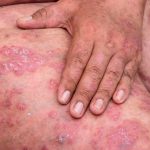 A malignancy of the skin is the most common, but most preventable, of all cancers. Most common in geographic areas in which people are excessively exposed to the sun’s ultra violet rays.
A malignancy of the skin is the most common, but most preventable, of all cancers. Most common in geographic areas in which people are excessively exposed to the sun’s ultra violet rays.
Neoplasm of the skin. Skin cancer is the most common and most curable malignancy. Sun or other source of ultraviolet-ray exposure (e.g., tanning salons) is a strong causative factor. Treatment depends on the location and extent of the neoplasm; it may involve surgery, radiotherapy, and/or chemotherapy.
The most common form of cancer in the United States. Skin cancer is linked to cumulative exposure or chronic exposure to the ultraviolet rays of the sun. While the risk of non¬ melanoma skin cancers increases with cumulative exposure to the sun, melanoma—the most serious type because it spreads to other organs— is linked to intermittent intense sun exposure, genetic factors, and moles. To detect skin cancer, doctors recommend regular self-examination. It is important to consult a doctor upon finding any new skin growth; a change in the surface or color of a mole; a spot or bump that is getting larger, scaling, oozing, or bleeding; a sore that does not heal within 3 months; or itchiness or pain in a lesion.
A broad term that includes basal cell carcinomas, squamous cell carcinomas, and melanomas. Together, these skin cancers are the most common cancers in the U.S. They are all associated with excessive exposure to ultraviolet light (e.g., sun exposure).
A cancerous skin growth, with forms such as basal cell carcinoma, squamous cell carcinoma, and malignant melanoma often linked to sun exposure. Another rare condition, Bowen’s disease, which has the potential to become cancerous, may also be sun-related. Less frequent types include Paget’s disease of the nipple and mycosis fungoides. Kaposi’s sarcoma is typically seen in patients with AIDS. Early treatment usually results in a high likelihood of curing most types of skin cancer.
